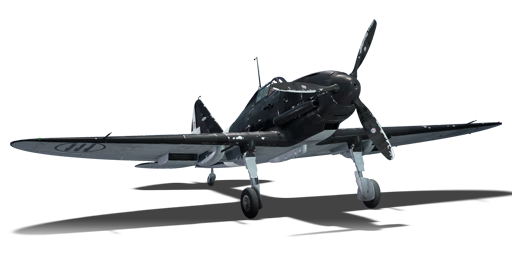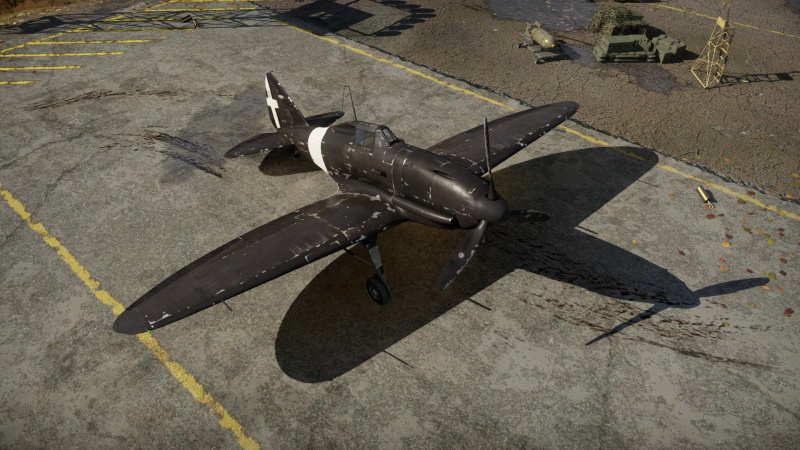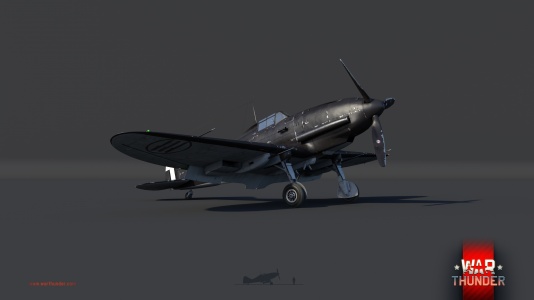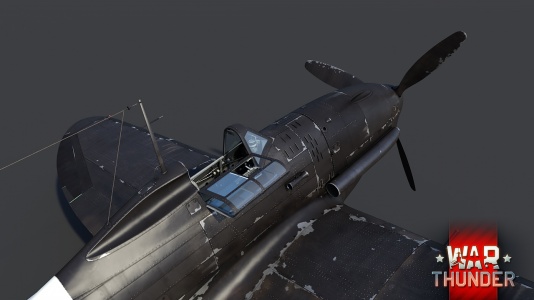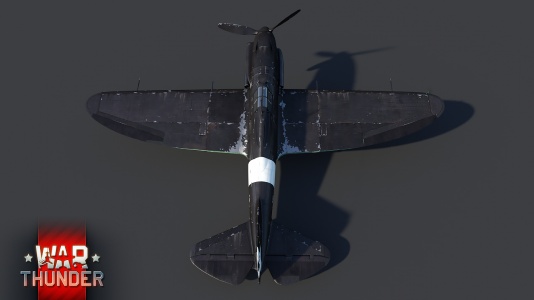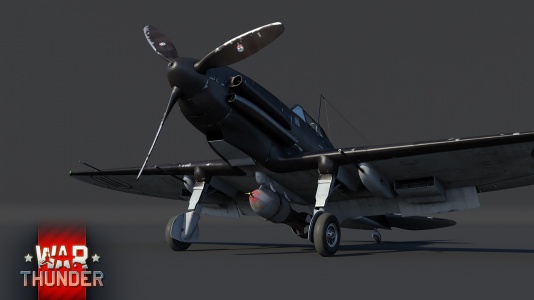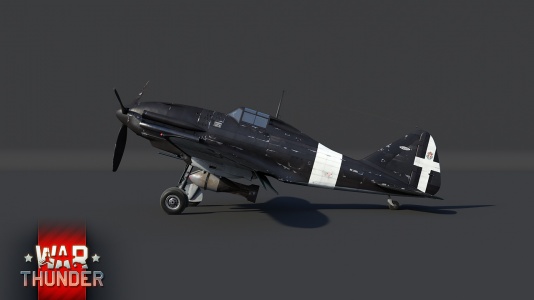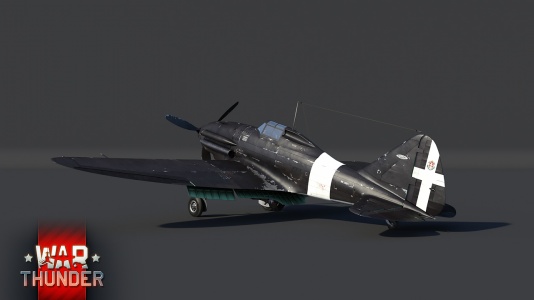Difference between revisions of "Re.2001 CN"
(added stats, fixed grammar errors and some general info update) (Tag: Visual edit) |
Colok76286 (talk | contribs) (Edits) |
||
| (24 intermediate revisions by 14 users not shown) | |||
| Line 1: | Line 1: | ||
| − | {{ | + | {{About |
| − | + | | about = Italian fighter '''{{PAGENAME}}''' | |
| + | | usage = other versions | ||
| + | | link = Re.2001 (Family) | ||
| + | }} | ||
| + | {{Specs-Card | ||
| + | |code=re_2001_cn | ||
| + | |images={{Specs-Card-Image|GarageImage_{{PAGENAME}}.jpg}} | ||
| + | }} | ||
| + | |||
== Description == | == Description == | ||
| − | <!--''In the description, the first part | + | <!-- ''In the description, the first part should be about the history of and the creation and combat usage of the aircraft, as well as its key features. In the second part, tell the reader about the aircraft in the game. Insert a screenshot of the vehicle, so that if the novice player does not remember the vehicle by name, he will immediately understand what kind of vehicle the article is talking about.'' --> |
| + | The '''{{Specs|name}}''' is a rank {{Specs|rank}} Italian fighter {{Battle-rating}}. It was introduced in [[Update 1.85 "Supersonic"]]. It provides a notable upgrade over the previous models with the inclusion of two [[MG 151/20 (20 mm)]] cannons mounted in the wings in place of the underwhelming 7.7 mm Breda-SAFATs. | ||
| − | |||
| − | |||
| − | |||
== General info == | == General info == | ||
| − | === Flight | + | === Flight performance === |
| − | <!--''Describe how the aircraft behaves in the air. | + | {{Specs-Avia-Flight}} |
| − | The Re.2001 CN provides an overall smooth flying experience, with a competitive turn rate, solid all-altitude performance, good elevator authority, moderate climb rate and | + | <!-- ''Describe how the aircraft behaves in the air. Speed, manoeuvrability, acceleration and allowable loads - these are the most important characteristics of the vehicle.'' --> |
| + | The Re.2001 CN "Falco II" provides an overall smooth flying experience, with a competitive turn rate, solid all-altitude performance, good elevator authority, and moderate climb rate. Its engine, the R.A.1000, is basically a more powerful and reliable DB 601. However, the Falco II is plagued by several critical weaknesses. Its speed is quite lacking when compared to contemporary fighters like the [[Bf 109 (Family)|Bf 109]], [[Spitfire (Family)|Spitfire]], and most American fighters you will encounter. It also has a relatively weak airframe and large fuel tanks which can be hit easily. The cooling system is wing-mounted and if damaged can reduce the effectiveness or even outright prevent the water-cooled inline engine from working properly. | ||
| + | |||
| + | In short, the Re.2001 CN is a plane which requires an able and smart pilot in order to make the most out of it, but when used correctly, it can be a fearful machine. | ||
| − | + | {| class="wikitable" style="text-align:center" width="70%" | |
| − | {| class="wikitable" style="text-align:center" | + | ! rowspan="2" | Characteristics |
| − | |||
| − | |||
| − | |||
| − | ! | ||
| − | |||
! colspan="2" | Max Speed<br>(km/h at 5,450 m) | ! colspan="2" | Max Speed<br>(km/h at 5,450 m) | ||
| − | ! rowspan="2" | Max altitude<br>( | + | ! rowspan="2" | Max altitude<br>(metres) |
! colspan="2" | Turn time<br>(seconds) | ! colspan="2" | Turn time<br>(seconds) | ||
| − | ! colspan="2" | Rate of climb<br>( | + | ! colspan="2" | Rate of climb<br>(metres/second) |
| − | ! rowspan="2" |Take-off run<br>( | + | ! rowspan="2" | Take-off run<br>(metres) |
| − | |||
| − | |||
| − | |||
| − | |||
| − | |||
| − | |||
| − | |||
| − | |||
| − | |||
| − | |||
| − | |||
|- | |- | ||
| − | ! | + | ! AB !! RB !! AB !! RB !! AB !! RB |
| − | ! | ||
| − | ! | ||
| − | ! | ||
| − | ! | ||
|- | |- | ||
| − | ! | + | ! Stock |
| − | + | | 501 || 484 || rowspan="2" | {{Specs|ceiling}} || 19.9 || 20.5 || 12.3 || 12.3 || rowspan="2" | 165 | |
| − | |||
| − | |||
| − | |||
| − | |||
|- | |- | ||
| − | |543||521|| | + | ! Upgraded |
| + | | 543 || 521 || 18.1 || 19.0 || 19.8 || 15.6 | ||
|- | |- | ||
|} | |} | ||
| − | ====Details==== | + | ==== Details ==== |
| − | {| class="wikitable" style="text-align:center" | + | {| class="wikitable" style="text-align:center" width="50%" |
|- | |- | ||
! colspan="5" | Features | ! colspan="5" | Features | ||
|- | |- | ||
| − | ! Combat | + | ! Combat flaps !! Take-off flaps !! Landing flaps !! Air brakes !! Arrestor gear |
| − | ! Take-off | ||
| − | ! Landing | ||
| − | ! Air brakes | ||
| − | ! Arrestor gear | ||
|- | |- | ||
| ✓ || ✓ || ✓ || X || X <!-- ✓ --> | | ✓ || ✓ || ✓ || X || X <!-- ✓ --> | ||
|- | |- | ||
|} | |} | ||
| − | {| class="wikitable" style="text-align:center" | + | |
| + | {| class="wikitable" style="text-align:center" width="50%" | ||
|- | |- | ||
| − | ! colspan=" | + | ! colspan="7" | Limits |
|- | |- | ||
| − | ! rowspan="2" | | + | ! rowspan="2" | Wings (km/h) |
| − | ! rowspan="2" | Gear | + | ! rowspan="2" | Gear (km/h) |
| − | ! | + | ! colspan="3" | Flaps (km/h) |
! colspan="2" | Max Static G | ! colspan="2" | Max Static G | ||
|- | |- | ||
| − | ! + | + | ! Combat !! Take-off !! Landing !! + !! - |
| − | ! - | ||
| − | |||
| − | |||
| − | |||
| − | |||
| − | |||
| − | |||
|- | |- | ||
| − | + | | {{Specs|destruction|body}} || {{Specs|destruction|gear}} || 455 || 420 || 250 || ~13 || ~9 | |
| − | | | ||
| − | |||
| − | |||
| − | |||
| − | |||
| − | | | ||
| − | | | ||
|- | |- | ||
|} | |} | ||
| Line 98: | Line 67: | ||
{| class="wikitable" style="text-align:center" | {| class="wikitable" style="text-align:center" | ||
|- | |- | ||
| − | ! colspan=" | + | ! colspan="4" | Optimal velocities (km/h) |
| − | |||
| − | |||
| − | |||
| − | |||
| − | |||
| − | |||
| − | |||
| − | |||
| − | |||
| − | |||
|- | |- | ||
| − | ! | + | ! Ailerons !! Rudder !! Elevators !! Radiator |
| − | ! | ||
| − | ! | ||
|- | |- | ||
| − | | | + | | < 350 || < 350 || < 420 || > 312 |
|- | |- | ||
| − | |||
| − | |||
| − | |||
| − | |||
| − | |||
| − | |||
| − | |||
| − | |||
|} | |} | ||
=== Survivability and armour === | === Survivability and armour === | ||
| − | <!--''Examine the survivability of the aircraft. Note how vulnerable the structure is and how secure the pilot is, whether the fuel tanks are armoured. Describe the armour, if there is any, also mention the vulnerability of other critical aircraft systems.''--> | + | {{Specs-Avia-Armour}} |
| + | <!-- ''Examine the survivability of the aircraft. Note how vulnerable the structure is and how secure the pilot is, whether the fuel tanks are armoured, etc. Describe the armour, if there is any, and also mention the vulnerability of other critical aircraft systems.'' --> | ||
* 8 mm Steel - Pilot's seat | * 8 mm Steel - Pilot's seat | ||
| − | * 8 mm Steel - | + | * 8 mm Steel - Armoured plate behind the pilot |
| − | * 50 mm Bulletproof glass - | + | * 50 mm Bulletproof glass - Armoured windscreen |
* Critical components located at the front of aircraft (pilot, engine, controls) | * Critical components located at the front of aircraft (pilot, engine, controls) | ||
* More fuel tanks located in wings near the fuselage | * More fuel tanks located in wings near the fuselage | ||
* Fuel tank in the fuselage behind the pilot | * Fuel tank in the fuselage behind the pilot | ||
| + | |||
| + | === Modifications and economy === | ||
| + | {{Specs-Economy}} | ||
| + | |||
| + | The stock Breda-SAFAT belts are very poor, containing mostly ball ammunition which causes little damage. It is recommended to upgrade those quickly. The upgraded belts for the Bredas themselves are quite good, but the potential damage is limited by the low muzzle velocity and poor ballistics beyond 300 m. The most important modules are Engine Injection, 20 mm belts/cannons, Engine, Compressor, Wing Repair then the survivability modules to help remedy the weak airframe. | ||
== Armaments == | == Armaments == | ||
| + | {{Specs-Avia-Armaments}} | ||
=== Offensive armament === | === Offensive armament === | ||
| − | <!--''Describe the offensive armament of the aircraft, if any. Describe how effective the cannons and machine guns are in a battle, and also what belts or drums are better to use. If there is no offensive weaponry, delete this subsection.''--> | + | {{Specs-Avia-Offensive}} |
| − | {{main|Breda-SAFAT | + | <!-- ''Describe the offensive armament of the aircraft, if any. Describe how effective the cannons and machine guns are in a battle, and also what belts or drums are better to use. If there is no offensive weaponry, delete this subsection.'' --> |
| + | {{main|MG 151 (20 mm)|Breda-SAFAT (12.7 mm)}} | ||
The '''''{{PAGENAME}}''''' is armed with: | The '''''{{PAGENAME}}''''' is armed with: | ||
| − | * 2 x | + | * 2 x 20 mm MG 151 cannons, wing-mounted (60 rpg = 120 total) |
| − | * 2 x | + | * 2 x 12.7 mm Breda-SAFAT machine guns, nose-mounted (350 rpg = 700 total) |
=== Suspended armament === | === Suspended armament === | ||
| − | <!--''Describe the aircraft's suspended armament: additional cannons under the wings, bombs, rockets and torpedoes. This section is especially important for bombers and attackers. If there is no suspended weaponry remove this subsection.''--> | + | {{Specs-Avia-Suspended}} |
| + | <!-- ''Describe the aircraft's suspended armament: additional cannons under the wings, bombs, rockets and torpedoes. This section is especially important for bombers and attackers. If there is no suspended weaponry remove this subsection.'' --> | ||
{{main|GP 250 (250 kg)}} | {{main|GP 250 (250 kg)}} | ||
| − | The '''''{{PAGENAME}}''''' can be outfitted with the following | + | The '''''{{PAGENAME}}''''' can be outfitted with the following ordnance: |
| − | *Without load | + | * Without load |
* 1 x 250 kg GP 250 bomb (250 kg total) | * 1 x 250 kg GP 250 bomb (250 kg total) | ||
| − | |||
| − | |||
| − | |||
| − | == Usage in | + | == Usage in battles == |
| − | <!--''Describe the tactics of playing in | + | <!-- ''Describe the tactics of playing in the aircraft, the features of using aircraft in a team and advice on tactics. Refrain from creating a "guide" - do not impose a single point of view, but instead, give the reader food for thought. Examine the most dangerous enemies and give recommendations on fighting them. If necessary, note the specifics of the game in different modes (AB, RB, SB).'' --> |
| + | The Re.2001 is a very manoeuvrable plane with decent performance at all altitudes. The great MG 151s (with access to devastating Minengeschoß rounds through the Air Targets belt), respectable climb rate, and good high altitude performance allow it to be an effective interceptor. With its ability to mount a single 250 kg bomb, it can also be a fighter bomber that can drop its payload and then join the furball as a regular fighter. | ||
| − | + | Generally speaking, the Breda-SAFATs have very poor ballistics from farther than 300 m, even with Air Targets belts. To make effective use of the Breda-SAFATs, they can be used as 'spotting guns' to line up shots with your MG 151s. This is critical as using as little 20 mm rounds as possible to destroy a plane is very important due to the low ammo count of only 60 rounds per gun. Ammo conservation of the MG 151 is critical, especially in RB/SB. | |
| − | ===Manual Engine Control=== | + | [[Spitfire (Family)|Spitfires]], Yaks, and [[A6M (Family)|A6M Zeroes]] are the kings of dogfighting below 3,000 m. If one attempts to fight you above 4,000 m, it is recommended to either make use their low speed at altitude to Boom-&-Zoom them or try to take a risk and turnfight them. The main reason the Re.2001 CN can turn fight with Spitfires and Yaks is due to its already good manoeuvrability made better by its combat flaps and decent rudder. A6M Zeroes will be able to outmanoeuvre the Re.2001 CN. The most common fighters of these types you will encounter are the [[Spitfire Mk Ia]] and [[Spitfire Mk IIa|Mk IIa]], [[Yak-1 (Family)|Yak-1]], [[Yak-7B]], early [[Yak-9 (Family)|Yak-9s]] and early [[A6M (Family)|A6M Zeroes]]. Keep in mind that damaged control surfaces and engine and cooling modules will reduce the agility of the Falco II and its ability to outmanoeuvre enemies. |
| + | |||
| + | The Re.2001 CN can be used quite effectively in ground attack. Its 250 kg bomb has a decent destruction radius due to its explosive mass and the aircraft's manoeuvrability can allow it to bomb very accurately. The 20 mm MG 151s can do a lot of damage to light targets, either by AP rounds punching through thin roof armor, or by HE rounds detonating on and around exposed crew members and ammo racks. During night missions, the Re.2001 CN's nearly all black night camouflage can assist in keeping the aircraft hidden from enemy fighters and SPAAs. | ||
| + | |||
| + | === Manual Engine Control === | ||
{| class="wikitable" style="text-align:center" | {| class="wikitable" style="text-align:center" | ||
|- | |- | ||
! colspan="7" | MEC elements | ! colspan="7" | MEC elements | ||
|- | |- | ||
| − | ! rowspan="2" |Mixer | + | ! rowspan="2" | Mixer |
| − | ! rowspan="2" |Pitch | + | ! rowspan="2" | Pitch |
| − | ! colspan="3" |Radiator | + | ! colspan="3" | Radiator |
| − | ! rowspan="2" |Supercharger | + | ! rowspan="2" | Supercharger |
| − | ! rowspan="2" |Turbocharger | + | ! rowspan="2" | Turbocharger |
| − | |||
| − | |||
| − | |||
| − | |||
| − | |||
| − | |||
| − | |||
| − | |||
| − | |||
| − | |||
| − | |||
| − | |||
| − | |||
| − | |||
| − | |||
| − | |||
| − | |||
| − | |||
| − | |||
| − | |||
| − | |||
| − | |||
| − | |||
| − | |||
| − | |||
| − | |||
| − | |||
| − | |||
| − | |||
|- | |- | ||
| − | + | ! Oil !! Water !! Type | |
| − | |||
| − | |||
| − | |||
| − | |||
| − | |||
|- | |- | ||
| − | | | + | | Not controllable || Controllable<br>Not auto controlled || Controllable<br>Not auto controlled || Controllable<br>Not auto controlled || Separate || Not controllable<br>1 gear || Not controllable |
| − | | | ||
| − | | | ||
| − | | | ||
| − | | | ||
| − | | | ||
|- | |- | ||
|} | |} | ||
| − | |||
=== Pros and cons === | === Pros and cons === | ||
| − | <!--''Summarise and briefly evaluate the vehicle | + | <!-- ''Summarise and briefly evaluate the vehicle in terms of its characteristics and combat effectiveness. Mark its pros and cons in the bulleted list. Try not to use more than 6 points for each of the characteristics. Avoid using categorical definitions such as "bad", "good" and the like - use substitutions with softer forms such as "inadequate" and "effective".'' --> |
'''Pros:''' | '''Pros:''' | ||
* Solid all-altitude performance | * Solid all-altitude performance | ||
| − | * | + | * Solid high-speed manoeuvrability |
| + | * Good turn rate | ||
| + | * Good energy retention | ||
| + | * Respectable climb rate | ||
* Responsive elevator | * Responsive elevator | ||
| + | * Decent roll rate at intermediate speeds | ||
* 50 mm bulletproof glass | * 50 mm bulletproof glass | ||
| − | |||
| − | |||
| − | |||
| − | |||
| − | |||
| − | |||
* Small target | * Small target | ||
| − | * | + | * Twin 20 mm MG 151s with access to Minengeschoß rounds |
| − | * | + | * Can mount a 250 kg bomb for ground attack |
* Can remain competitive when up-tiered | * Can remain competitive when up-tiered | ||
| − | |||
| − | '''Cons:''' | + | '''Cons:''' |
| − | * Weak Breda-SAFAT | + | * Slow speed; can be outrun by many fighters at its BR |
| + | * Weak airframe | ||
| + | * Large fuel tanks can get hit easily | ||
| + | * Cooling systems are wing-mounted and unarmored, leaving them vulnerable to damage | ||
| + | * Engine overheats quickly | ||
| + | * 12.7 mm Breda-SAFAT machine guns have a slow fire rate and lose effectiveness past 300 m | ||
* Cannons are mounted in the wings, resulting in significant convergence. | * Cannons are mounted in the wings, resulting in significant convergence. | ||
| − | * | + | * Limited 20 mm ammunition count (60 rpg) |
| − | |||
| − | |||
| − | |||
| − | |||
| − | |||
| − | |||
== History == | == History == | ||
| − | <!--''Describe the history of the creation and combat usage of the aircraft in more detail than in the introduction. If the historical reference turns out to be too | + | <!-- ''Describe the history of the creation and combat usage of the aircraft in more detail than in the introduction. If the historical reference turns out to be too long, take it to a separate article, taking a link to the article about the vehicle and adding a block "/History" (example: <nowiki>https://wiki.warthunder.com/(Vehicle-name)/History</nowiki>) and add a link to it here using the <code>main</code> template. Be sure to reference text and sources by using <code><nowiki><ref></ref></nowiki></code>, as well as adding them at the end of the article with <code><nowiki><references /></nowiki></code>. This section may also include the vehicle's dev blog entry (if applicable) and the in-game encyclopedia description (under <code><nowiki>=== In-game description ===</nowiki></code>, also if applicable).'' --> |
| − | The Reggiane Re.2001 was designed to be a replacement for the failed Re.2000, and did away with the weak Piaggio P.IX radial, in favour of a new, more powerful R.A.1000RC.41-1a Inline (which was a fiat built, more powerful and reliable DB 601A, the same engine used in the early BF | + | The Reggiane Re.2001 was designed to be a replacement for the failed Re.2000, and did away with the weak Piaggio P.IX radial, in favour of a new, more powerful R.A.1000RC.41-1a Inline (which was a fiat built, more powerful and reliable DB 601A, the same engine used in the early BF 109s). Other than the engine and shape of the nose, there were no real notable changes between the Falco I and Falco II. The Falco II retained a fairly similar fuselage and even kept the entire tail unit. While considered to be equal to the Macchi MC.202, the MC.202 had the first call on the R.A.1000, and the Re.2001 was delayed by several design changes the Italian army insisted on, giving the MC.202 almost a full year head-start on its rival, leading to more Macchi fighters being produced than Reggiane fighters. |
Despite its late introduction and production issues, it received a mostly positive reception from the Italian pilots, as it was proven to be a thorn in the side of Spitfire and Hurricane pilots. Jack Rae, the best New Zealand Spitfire pilot, exclaimed that the Re.2001 he encountered was a surprisingly dangerous opponent, saying that he almost "spun off" twice while trying to pursue him and found it hard to get an excellent shot on the Italian plane. | Despite its late introduction and production issues, it received a mostly positive reception from the Italian pilots, as it was proven to be a thorn in the side of Spitfire and Hurricane pilots. Jack Rae, the best New Zealand Spitfire pilot, exclaimed that the Re.2001 he encountered was a surprisingly dangerous opponent, saying that he almost "spun off" twice while trying to pursue him and found it hard to get an excellent shot on the Italian plane. | ||
| − | The CN variant was a Night Fighter and Fighter Bomber able to mount an optional payload of 640 kg | + | The CN variant was a Night Fighter and Fighter Bomber able to mount an optional payload of 640 kg and fitted with two Mauser MG 151/20 in gondolas under the wings and was primarily used in defence of Italian cities. |
== Media == | == Media == | ||
| − | '' | + | <!-- ''Excellent additions to the article would be video guides, screenshots from the game, and photos.'' --> |
| + | |||
| + | ;Skins | ||
| + | * [https://live.warthunder.com/feed/camouflages/?vehicle=re_2001_cn Skins and camouflages for the {{PAGENAME}} from live.warthunder.com.] | ||
| + | |||
| + | ;Images | ||
| + | <gallery mode="packed" heights="200"> | ||
| + | File:Re 2001 CN WTWallpaper 001.jpg | ||
| + | File:Re 2001 CN WTWallpaper 002.jpg | ||
| + | File:Re 2001 CN WTWallpaper 003.jpg | ||
| + | File:Re 2001 CN WTWallpaper 004.jpg | ||
| + | File:Re 2001 CN WTWallpaper 005.jpg | ||
| + | File:Re 2001 CN WTWallpaper 006.jpg | ||
| + | </gallery> | ||
| + | |||
| + | ;Videos | ||
| + | {{Youtube-gallery|uCO0chq-xcw|'''The Shooting Range #186''' - ''Pages of History'' section at 04:10 discusses the Re.2001.}} | ||
| − | == | + | == See also == |
| − | ''Links to the articles on the War Thunder Wiki that you think will be useful for the reader, for example | + | ''Links to the articles on the War Thunder Wiki that you think will be useful for the reader, for example:'' |
* ''reference to the series of the aircraft;'' | * ''reference to the series of the aircraft;'' | ||
* ''links to approximate analogues of other nations and research trees.'' | * ''links to approximate analogues of other nations and research trees.'' | ||
| − | |||
| − | == | + | == External links == |
| − | ''Paste links to sources and external resources, such as:'' | + | <!-- ''Paste links to sources and external resources, such as:'' |
| + | * ''topic on the official game forum;'' | ||
| + | * ''other literature.'' --> | ||
| − | * | + | * [[wt:en/news/5974-development-reggiane-re-2001-cn-the-black-falcon-en|[Devblog] Reggiane Re.2001 CN: The Black Falcon]] |
| − | * | + | * [https://forum.warthunder.com/index.php?/topic/436315-re-2001-cn/ Official data sheet - more details about the performance] |
| − | |||
| + | {{AirManufacturer Reggiane}} | ||
{{Italy fighters}} | {{Italy fighters}} | ||
Latest revision as of 12:13, 3 February 2022
| This page is about the Italian fighter Re.2001 CN. For other versions, see Re.2001 (Family). |
Contents
Description
The Re.2001 CN is a rank III Italian fighter with a battle rating of 4.3 (AB) and 3.3 (RB/SB). It was introduced in Update 1.85 "Supersonic". It provides a notable upgrade over the previous models with the inclusion of two MG 151/20 (20 mm) cannons mounted in the wings in place of the underwhelming 7.7 mm Breda-SAFATs.
General info
Flight performance
The Re.2001 CN "Falco II" provides an overall smooth flying experience, with a competitive turn rate, solid all-altitude performance, good elevator authority, and moderate climb rate. Its engine, the R.A.1000, is basically a more powerful and reliable DB 601. However, the Falco II is plagued by several critical weaknesses. Its speed is quite lacking when compared to contemporary fighters like the Bf 109, Spitfire, and most American fighters you will encounter. It also has a relatively weak airframe and large fuel tanks which can be hit easily. The cooling system is wing-mounted and if damaged can reduce the effectiveness or even outright prevent the water-cooled inline engine from working properly.
In short, the Re.2001 CN is a plane which requires an able and smart pilot in order to make the most out of it, but when used correctly, it can be a fearful machine.
| Characteristics | Max Speed (km/h at 5,450 m) |
Max altitude (metres) |
Turn time (seconds) |
Rate of climb (metres/second) |
Take-off run (metres) | |||
|---|---|---|---|---|---|---|---|---|
| AB | RB | AB | RB | AB | RB | |||
| Stock | 501 | 484 | 11000 | 19.9 | 20.5 | 12.3 | 12.3 | 165 |
| Upgraded | 543 | 521 | 18.1 | 19.0 | 19.8 | 15.6 | ||
Details
| Features | ||||
|---|---|---|---|---|
| Combat flaps | Take-off flaps | Landing flaps | Air brakes | Arrestor gear |
| ✓ | ✓ | ✓ | X | X |
| Limits | ||||||
|---|---|---|---|---|---|---|
| Wings (km/h) | Gear (km/h) | Flaps (km/h) | Max Static G | |||
| Combat | Take-off | Landing | + | - | ||
| 740 | 320 | 455 | 420 | 250 | ~13 | ~9 |
| Optimal velocities (km/h) | |||
|---|---|---|---|
| Ailerons | Rudder | Elevators | Radiator |
| < 350 | < 350 | < 420 | > 312 |
Survivability and armour
- 8 mm Steel - Pilot's seat
- 8 mm Steel - Armoured plate behind the pilot
- 50 mm Bulletproof glass - Armoured windscreen
- Critical components located at the front of aircraft (pilot, engine, controls)
- More fuel tanks located in wings near the fuselage
- Fuel tank in the fuselage behind the pilot
Modifications and economy
The stock Breda-SAFAT belts are very poor, containing mostly ball ammunition which causes little damage. It is recommended to upgrade those quickly. The upgraded belts for the Bredas themselves are quite good, but the potential damage is limited by the low muzzle velocity and poor ballistics beyond 300 m. The most important modules are Engine Injection, 20 mm belts/cannons, Engine, Compressor, Wing Repair then the survivability modules to help remedy the weak airframe.
Armaments
Offensive armament
The Re.2001 CN is armed with:
- 2 x 20 mm MG 151 cannons, wing-mounted (60 rpg = 120 total)
- 2 x 12.7 mm Breda-SAFAT machine guns, nose-mounted (350 rpg = 700 total)
Suspended armament
The Re.2001 CN can be outfitted with the following ordnance:
- Without load
- 1 x 250 kg GP 250 bomb (250 kg total)
Usage in battles
The Re.2001 is a very manoeuvrable plane with decent performance at all altitudes. The great MG 151s (with access to devastating Minengeschoß rounds through the Air Targets belt), respectable climb rate, and good high altitude performance allow it to be an effective interceptor. With its ability to mount a single 250 kg bomb, it can also be a fighter bomber that can drop its payload and then join the furball as a regular fighter.
Generally speaking, the Breda-SAFATs have very poor ballistics from farther than 300 m, even with Air Targets belts. To make effective use of the Breda-SAFATs, they can be used as 'spotting guns' to line up shots with your MG 151s. This is critical as using as little 20 mm rounds as possible to destroy a plane is very important due to the low ammo count of only 60 rounds per gun. Ammo conservation of the MG 151 is critical, especially in RB/SB.
Spitfires, Yaks, and A6M Zeroes are the kings of dogfighting below 3,000 m. If one attempts to fight you above 4,000 m, it is recommended to either make use their low speed at altitude to Boom-&-Zoom them or try to take a risk and turnfight them. The main reason the Re.2001 CN can turn fight with Spitfires and Yaks is due to its already good manoeuvrability made better by its combat flaps and decent rudder. A6M Zeroes will be able to outmanoeuvre the Re.2001 CN. The most common fighters of these types you will encounter are the Spitfire Mk Ia and Mk IIa, Yak-1, Yak-7B, early Yak-9s and early A6M Zeroes. Keep in mind that damaged control surfaces and engine and cooling modules will reduce the agility of the Falco II and its ability to outmanoeuvre enemies.
The Re.2001 CN can be used quite effectively in ground attack. Its 250 kg bomb has a decent destruction radius due to its explosive mass and the aircraft's manoeuvrability can allow it to bomb very accurately. The 20 mm MG 151s can do a lot of damage to light targets, either by AP rounds punching through thin roof armor, or by HE rounds detonating on and around exposed crew members and ammo racks. During night missions, the Re.2001 CN's nearly all black night camouflage can assist in keeping the aircraft hidden from enemy fighters and SPAAs.
Manual Engine Control
| MEC elements | ||||||
|---|---|---|---|---|---|---|
| Mixer | Pitch | Radiator | Supercharger | Turbocharger | ||
| Oil | Water | Type | ||||
| Not controllable | Controllable Not auto controlled |
Controllable Not auto controlled |
Controllable Not auto controlled |
Separate | Not controllable 1 gear |
Not controllable |
Pros and cons
Pros:
- Solid all-altitude performance
- Solid high-speed manoeuvrability
- Good turn rate
- Good energy retention
- Respectable climb rate
- Responsive elevator
- Decent roll rate at intermediate speeds
- 50 mm bulletproof glass
- Small target
- Twin 20 mm MG 151s with access to Minengeschoß rounds
- Can mount a 250 kg bomb for ground attack
- Can remain competitive when up-tiered
Cons:
- Slow speed; can be outrun by many fighters at its BR
- Weak airframe
- Large fuel tanks can get hit easily
- Cooling systems are wing-mounted and unarmored, leaving them vulnerable to damage
- Engine overheats quickly
- 12.7 mm Breda-SAFAT machine guns have a slow fire rate and lose effectiveness past 300 m
- Cannons are mounted in the wings, resulting in significant convergence.
- Limited 20 mm ammunition count (60 rpg)
History
The Reggiane Re.2001 was designed to be a replacement for the failed Re.2000, and did away with the weak Piaggio P.IX radial, in favour of a new, more powerful R.A.1000RC.41-1a Inline (which was a fiat built, more powerful and reliable DB 601A, the same engine used in the early BF 109s). Other than the engine and shape of the nose, there were no real notable changes between the Falco I and Falco II. The Falco II retained a fairly similar fuselage and even kept the entire tail unit. While considered to be equal to the Macchi MC.202, the MC.202 had the first call on the R.A.1000, and the Re.2001 was delayed by several design changes the Italian army insisted on, giving the MC.202 almost a full year head-start on its rival, leading to more Macchi fighters being produced than Reggiane fighters.
Despite its late introduction and production issues, it received a mostly positive reception from the Italian pilots, as it was proven to be a thorn in the side of Spitfire and Hurricane pilots. Jack Rae, the best New Zealand Spitfire pilot, exclaimed that the Re.2001 he encountered was a surprisingly dangerous opponent, saying that he almost "spun off" twice while trying to pursue him and found it hard to get an excellent shot on the Italian plane.
The CN variant was a Night Fighter and Fighter Bomber able to mount an optional payload of 640 kg and fitted with two Mauser MG 151/20 in gondolas under the wings and was primarily used in defence of Italian cities.
Media
- Skins
- Images
- Videos
See also
Links to the articles on the War Thunder Wiki that you think will be useful for the reader, for example:
- reference to the series of the aircraft;
- links to approximate analogues of other nations and research trees.
External links
- [Devblog] Reggiane Re.2001 CN: The Black Falcon
- Official data sheet - more details about the performance
| Reggiane Mechanical Factory (Officine Meccaniche Reggiane SpA) | |
|---|---|
| Fighters | Re.2000 serie 1 · Re.2000 G.A. |
| Re.2001 serie 1 · Re.2001 gruppo 22 · Re.2001 CB · Re.2001 CN | |
| Re.2002 Early | |
| Re.2005 serie 0 | |
| Export | J20 |
| Italy fighters | |
|---|---|
| Fiat | CR.32 · CR.32 bis · CR.32 quater · CR.42 · Marcolin's C.R.42 CN |
| G.50 serie 2 · G.50 AS serie 7 | |
| G.55 sottoserie 0 · G.55 serie 1 · G.55S · G.56 | |
| Reggiane | Re.2000 G.A. · Re.2000 serie 1 |
| Re.2001 serie 1 · Re.2001 gruppo 22 · Re.2001 CB · Re.2001 CN | |
| Re.2002 Early | |
| Re.2005 serie 0 | |
| Macchi | C. 200 serie 3 · C. 200 serie 7 |
| C. 202 · C. 202D · C. 202EC | |
| C. 205 serie 1 · C. 205 serie 3 · C. 205N2 | |
| IMAM | Ro.44 |
| Foreign: | |
| Germany | ▄Bf 109 G-14/AS |
| USA | ▄P-47D-30 |
| Britain | ▄Spitfire Mk Vb/trop |
| Hungary | ◐Bf 109 F-4 · ◐Bf 109 G-2 · ◔Yak-9P |
| Romania | He 112 B-1/U2 · IAR-81C |


